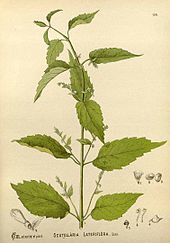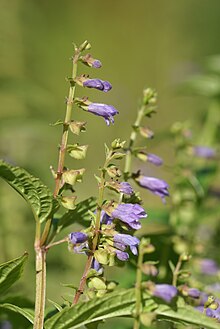bio.wikisort.org - Plant
Scutellaria lateriflora, (commonly "blue skullcap", "mad dog skullcap",[1][2], "American skullcap", "side-flowering skullcap", etc.) is a hardy perennial herb of the mint family, Lamiaceae, native to North America.
It has an upright habit, growing 60–80 cm (24–31 inches) in maximum height.[3][4] It is a wetland-loving species and grows near marshes, meadows, and other wet habitat. The blue flowers are just under 1 cm (0.4 inches) long.[3][4] Most of the flowers do not appear at the top of the main stem, but are produced along the length of side branches that grow from the leaf axils.
Traditional uses and research
Scutellaria lateriflora contains flavonoids.[5] Other skullcaps (Scutellaria species) used for similar purposes include common skullcap (S. galericulata), western skullcap (S. canescens), and southern skullcap (S. cordifolia). Its extracts are used in herbal medicine intended as a mild sedative and sleep promoter.[5] Cherokee women have used it as an emmenagogue.[6] In 1773, Scutellaria lateriflora became a common treatment in North America for the hysteria and hydrophobia caused by rabies.[7]
Skullcap products have been analyzed, with some adulterated by Teucrium canadense or T. chamaedrys, also known as germander, which contains potentially hepatotoxic diterpenes.[5]
β-Elemene in the herb is under preliminary research in vitro,[8] but studies in humans have not confirmed any efficacy.[9] Diterpenes isolated from S. barbata had cytotoxic activity against three human cancer cell lines in vitro.[10]
Pharmacology

This section needs more medical references for verification or relies too heavily on primary sources. (April 2014) |
The principal phenolics in the leaves, stems, and roots of some Scutellaria species are baicalin, baicalein, wogonin, and oroxylin A.[11][12] Baicalin has anti-inflammatory and analgesic effects in a rat model of thermal hyperalgesia.[13][14] Another study identifies 5,6,7-trihydroxy-2'- methoxyflavone and its 7-O-glucuronide.[15] A number of the flavones found in S. lateriflora have been reported to selectively bind with high affinity to central benzodiazepine receptor sites, leading to the view that the flavones exert anxiolytic and other benzodiazepine effects in rats.[16]
Scutellarin is a flavone found in S. lateriflora and S. barbata that has been investigated as a treatment for a variety of conditions. It is transformed by hydrolysis into scutellarein.
The flavonoids are found throughout the plant but are more concentrated in the leaves, and the concentrations are found to decrease slightly as the plant matures. The dried leaf is reported to contain about 50 milligrams of flavonoid per gram. The flavonoids are readily extracted using hot water.[14]
Composition
| Chemical | Concentration (mg/g) |
|---|---|
| alpha-cubebene | 42 |
| alpha-humulene | 42 |
| beta-elemene | 92 |
| calamenene | 152 |
| delta-cadinene | 270 |
| Chemical | Concentration (mg/g) |
|---|---|
| carbohydrates | 780 |
| ascorbic acid | 1 |
| baicalin | 10[17] |
| scutellarin | |
| scutellarein | |
| tannin | 28-35 |
| wax | 12 |
See also
Other plants with sedative GABAergic properties
- Piper methysticum (kava)
- Valeriana officinalis (valerian)
- Melissa officinalis (lemon balm)
- Eschscholzia californica (California poppy)
References
- Scutellaria lateriflora. NatureServe. 2012.
- mad dog, n. -compounds Oxford English Dictionary - mad dog because it was a supposed cure for hydrophobia
- Jepson Manual Treatment
- Washington Burke Museum
- Lin, L. Z.; Harnly, J. M.; Upton, R (2009). "Comparison of the Phenolic Component Profiles of Skullcap (Scutellaria lateriflora) and Germander (Teucrium canadense and T. Chamaedrys), a Potentially Hepatotoxic Adulterant". Phytochemical Analysis. 20 (4): 298–306. doi:10.1002/pca.1127. PMC 3583524. PMID 19402188.
- Joshee N, Patrick TS, Mentreddy RS, Yadav AK. 2002. Skullcap: Potential medicinal crop. In: J Janick,A Whipkey (eds). In Trends in New Crops and New Uses. ASHS Press: Alexandria, VA; 580– 586.
- Scutellaria lateriflora. Southern Cross Plant Science. Southern Cross University.
- Li QQ, et al. (2010). "Antineoplastic effect of β-elemene on prostate cancer cells and other types of solid tumour cells". Journal of Pharmacy and Pharmacology. 62 (8): 1018–27. doi:10.1111/j.2042-7158.2010.01135.x. PMID 20663036. S2CID 12622379.
- Peng X, et al. (2006). "Assessing the quality of RCTs on the effect of β-elemene, one ingredient of a Chinese herb, against malignant tumors". Contemporary Clinical Trials. 27 (1): 70–82. doi:10.1016/j.cct.2005.07.002. PMID 16243588.
- Qu GW, et al. (2010). "Two new cytotoxic ent-clerodane diterpenoids from Scutellaria barbata". Journal of Asian Natural Products Research. 12 (10): 859–64. doi:10.1080/10286020.2010.507546. PMID 20924899. S2CID 25504133.
- Nishikawa K, et al. (1999). "Phenolics in tissue cultures of Scutellaria" (PDF). Natural Medicines. 53 (4): 209–13.
- Li J, Ding Y, Li XC, Ferreira D, Khan S, Smillie T, Khan IA (2009). "Scuteflorins A and B, dihydropyranocoumarins from Scutellaria lateriflora". J. Nat. Prod. 72 (6): 983–7. doi:10.1021/np900068t. PMID 19555121.
- Chou, Tz-Chong; Chang, Li-Ping; Li, Chi-Yuan; Wong, Chih-Shung; Yang, Shih-Ping (2003). "The Antiinflammatory and Analgesic Effects of Baicalin in Carrageenan-Evoked Thermal Hyperalgesia". Anesth Analg. 97 (6): 1724–1729. doi:10.1213/01.ane.0000087066.71572.3f. PMID 14633550. S2CID 24387980.
- Bergeron, Chantal; Gafner, Stefan; Clausen, Edgar; Carrier, Danielle J. (2005). "Scutellaria lateriflora Using Accelerated Solvent Extraction and Supercritical Fluid Extraction versus Standard Hot Water or 70% Ethanol Extraction". J. Agric. Food Chem. 53 (8): 3076–3080. doi:10.1021/jf048408t. PMID 15826062.
- Analysis of Scutellaria lateriflora and its adulterant Teucrium canadense by HPLC-UV and HPLC-UV/MS, Tom's of Maine, PO Box 710, Kennebunk, ME 04043. USA.
- Medina JH, et al. (1997). "Overview – Flavonoids: A new family of benzodiazepine receptor ligands". Neurochemical Research. 22 (4): 419–25. doi:10.1023/A:1027303609517. PMID 9130252. S2CID 22552052.
- P.H. and Horhammer, L., Hager's Handbuch der Pharmazeutischen Praxis, Vols. 2-6, Springer-Verlag, Berlin, 1969-1979.
External links
- Connecticut Botanical Society: Scutellaria lateriflora
- Plants For A Future: Scutellaria lateriflora
- USDA Plants Profile: Scutellaria lateriflora
- Dr. Duke's Phytochemical and Ethnobotanical Databases
На других языках
- [en] Scutellaria lateriflora
[es] Scutellaria lateriflora
La esculetaria de Virginia, Scutellaria lateriflora, es una especie de planta herbácea de la familia Lamiaceae natural de Norteamérica donde crece en lugares húmedos en los bosques.Другой контент может иметь иную лицензию. Перед использованием материалов сайта WikiSort.org внимательно изучите правила лицензирования конкретных элементов наполнения сайта.
WikiSort.org - проект по пересортировке и дополнению контента Википедии

